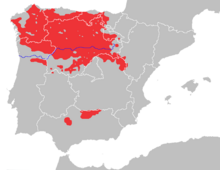Iberian wolf
The Iberian wolf is a form of the wolf that colonizes the Iberian Peninsula . Due to the differences in morphology and behavior, it was described by Ángel Cabrera Latorre in 1907 as a separate subspecies Canis lupus signatus . Today, however, it is mostly assumed that the Iberian wolf belongs to the same subspecies as the Eurasian wolf ( Canis lupus lupus ).
features
The Iberian wolf is gray-brown in color and is slightly narrower than some other forms of the Eurasian wolf . Characteristic are the black markings on the forelegs and the tail, as well as the white coloring of the upper lip. Adult males reach a length of 120 to 140 cm and a weight of 30 to 40 kg and a shoulder height of up to 70 cm. Females are slightly smaller with a length of 100 to 120 cm and a weight of 20 to 35 kg.
Another peculiarity of the Iberian wolves is that, unlike other Eurasian wolves, they do not form larger packs, but live in small family groups, usually consisting of the parents with the young animals of a year.
nutrition
According to a study by the Spanish naturalist Félix Rodríguez de la Fuente , the largest part of the diet of wolves in Spain is made up of around 35% medium-sized to large herbivorous mammals, such as. B. red deer and fallow deer , roe deer , chamois , ibex , wild boar or mouflon . In second place are farm animals, especially sheep , which make up around 24%. Iberian wolves also prey on hares , rabbits , voles and, to a lesser extent, reptiles and birds. Occasionally, they also kill foxes or domestic dogs . In times when there is little food, the wolf also eats carrion and waste .
distribution
Historical
Until the 19th century, wolves were native to the entire Iberian Peninsula. In the 20th century, however, there was active persecution of the animals considered pests, which led to a rapid decline in the population. In the early 1970s, the population reached a low point, the habitat was limited to the extreme northwest of the country, especially along the Cantabrian Mountains , as well as some packs in the Andalusian Sierra Morena .
Current
From the 1970s onwards, strict protective measures led to a recovery of the wolf population and an expansion of the range. Currently, between 2,000 and 2,400 wolves live on the Iberian Peninsula, 1,500 to 2,000 of them in Spain and around 300 to 400 in Portugal , making the Iberian wolves the largest and most stable population in Western Europe. The distribution area extends over large parts of north-west and central Spain as well as the north of Portugal.
The largest population is found in the Sierra de la Culebra, Zamora province . Other important areas are in the provinces of León , Palencia and Burgos and in the autonomous communities of Asturias , Galicia and Cantabria . In Galicia there are even packs of wolves in coastal areas ( Sierra del Barbanza ), where they occasionally attack semi-wild horses.
Smaller wolf populations can be found in Soria (Sierra de Urbión), Valladolid , Segovia , La Rioja ( Sierra de la Demanda ), Álava and Guadalajara (Sierra de Ayllón) , among others . The population in the Sierra de San Pedro ( Cáceres , Extremadura ) seems to be extinct.
A small and acutely threatened population still exists in northern Andalusia, on the eastern Sierra Morena, in particular the Sierra de Andújar ( Jaén ). The medium-term goal of conservationists to preserve the latter is to connect the north-western and southern habitats of the Iberian wolves.
Hazard and protection
The Iberian wolf is classified in the Libro rojo de los vertebrados de España 'Red List of Spanish Vertebrates' as vulnerable 'endangered' . The Atlas y Libro Rojo de mamíferos terrestres de España 'Atlas and Red List of Land Mammals of Spain' lists it in the NT category ( Near Threatened 'low risk' ).
In Spain , with the exception of the Autonomous Community of Asturias , the wolf is legally hunted north of the Duero , where the population is considered stable . It is under strict protection south of the Duero and in Portugal. Poaching and the laying of poison baits are still a problem for the population, especially for the acutely threatened southern populations.
literature
- Ramón Grande del Brío: El lobo ibérico. Biología, ecología y comportamiento . Amarú, Salamanca 2000, ISBN 978-84-8196-075-4 (Spanish).
Individual evidence
- ↑ Angel Cabrera: Los lobos de España. In: Boletín de la Real Sociedad Española de Historia Natural. Tomo VII. No. 3, 1907, pp. 193-198.
- ^ Claudio Sillero-Zubiri: Family Canidae (Dogs). In: Don E. Wilson , Russell A. Mittermeier (eds.): Handbook of the Mammals of the World. Volume 1: Carnivores. Lynx Edicions, Barcelona 2009, ISBN 978-84-96553-49-1 , pp. 352-446, here p. 413.
- ^ Lobo ibérico (Canis lupus signatus). In: faunaiberica.org . Retrieved April 14, 2010 (Spanish).
- ↑ Juan Carlos Blanco, Luis Cuesta, Santiago Reig: El lobo en España: una vision global. (PDF) In: Ministerio de Medio Ambiente . Retrieved April 14, 2010 (Spanish).
- ↑ Canis lupus. (PDF; 34.3 kB) In: Ministerio de Medio Ambiente . Retrieved July 23, 2012 (Spanish).
- ↑ Juan Carlos Blanco, Mario Sáenz de Buruaga, Luis Llaneza: Lobo. (PDF; 1.4 MB) In: Ministerio de Medio Ambiente . Retrieved July 23, 2012 (Spanish).
- ↑ Directive 92/43 / EEC of the Council of May 21, 1992 on the conservation of natural habitats and of wild animals and plants , accessed on April 14, 2010
- ↑ LEY 42/2007, de 13 de diciembre, del Patrimonio Natural y de la Biodiversidad. (PDF; 353 kB) In: Boletín Oficial del Estado . December 13, 2007, Retrieved July 23, 2012 (Spanish).

